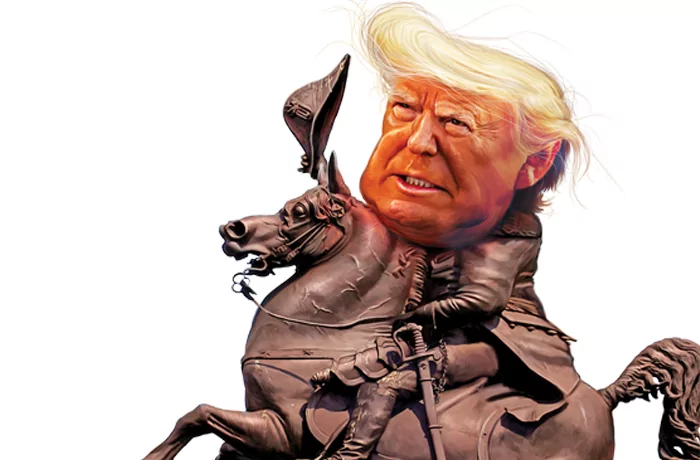We are fast approaching the 100th day of President Donald Trump’s second term, which is coming at the end of April. Unlike Trump’s first go-round, his tenure has been focused, energetic, and vigorous. The Trump administration of 2017 was already damaged at this point by useless fights over inaugural crowd sizes and the accusation that the president was tied to Russia. This time around, the administration has been (mostly) no-nonsense.
And purposeful. Trump’s second term has been the most anti-government administration since Ronald Reagan’s, arguably even more so. Trump’s first term was too ideologically confused, politically unfocused, and inexperienced in the ways of D.C. politics to have much of an agenda. If anything, Trump 45 was traditionally Republican in its program, with tax cuts and judges approved by the Federalist Society. Trump’s two Republican predecessors, George H.W. Bush and George W. Bush, endeavored to make peace with the size of the federal government, with the former agreeing to tax increases and the latter arguing that it could be directed to conservative ends.
It was Reagan who argued in his first inaugural address, “In this present crisis, government is not the solution to our problem; government is the problem.” That comes closest to Trump 47, but the current president arguably has a more sweeping agenda.

Reagan’s interest was mainly in reducing the burden of government on businesses and taxpayers. Trump believes that the administrative state, in conjunction with the media, the Democratic Party, and affiliated nongovernmental organizations, attempted not only to destroy his first presidency but to destroy him personally. He sees a vast political machine — akin to Tammany Hall, the Democratic operation that ran New York City for generations — that is feeding off taxpayers, pushing an agenda the people do not support, and steamrolling any opponents who stand in its way. Trump’s intention is to destroy it.
In this way, Trump has finally come to embody Andrew Jackson, whose portrait hangs in the Oval Office. In 1832, Jackson was convinced that the president of the Bank of the United States, Nicholas Biddle, was using the bank’s wealth and influence to defeat Jackson in the election. The president famously said to Martin Van Buren, “The bank, Mr. Van Buren, is trying to kill me, but I will kill it.” Old Hickory, as Jackson was known, made good on the pledge. Despite his dubious legal authorization to do so, Jackson removed federal deposits from the bank, leading to its undoing.
Trump seeks the same destruction of those who, in his view, abused their power to undermine him. That he has been able to wreak so much havoc within the administrative state has surprised many commentators, but those who have watched Congress carefully over the years are hardly shocked. For generations, Congress has written vague regulations and ambiguous appropriations, which have channeled de facto legislative power to the president. The expectation has always been that the president would behave in a certain way, abiding by a generations-long yet informal agreement about the role and discretion of the administrative state. Trump, after his experiences over the last nine years, is having none of that. He is using the tools that Democratic and Republican Congresses gave the president to remake the government.
The dismantling of the U.S. Agency for International Development is perhaps the most shocking illustration of that. How could the president possibly take apart an administrative agency? Because Congress never bothered to write a law to establish it.
And note that Trump has done all this without enabling legislation. Congress, controlled by Republicans who owe their majorities to him, is right now crafting laws that will make permanent the changes he has made and give him the ability to go further.
Trump’s agenda seems more to be about reorienting political power in Washington than putting the government on a sustainable fiscal path. The deficit in fiscal 2025 was roughly $750 billion in the first quarter alone. It goes without saying that every dollar counts, but if the goal is to make the government sustainable, cutting foreign aid is merely a drop in the ocean. The most profligate agencies in the history of the entire world are the Department of Defense and the Centers for Medicare and Medicaid Services. Trillions of dollars pass through these two locales, year in and year out. This is where the money is really being wasted. Yet Trump has not touched them to date, and in the past, he has campaigned on leaving Medicare alone. Moreover, he seems poised to use the money saved from his slashing of the state not to right the badly tilting fiscal ship but by eliminating taxes on tips and Social Security.
It seems clear that Trump’s real goal is to destroy the Democratic power base in the government while locking in his coalition of the working class. The unsustainable trajectory of federal spending is a secondary matter at best.
Politically, this makes sense. There is little sympathy in the Republican coalition right now for the NGOs that have fattened themselves at the federal trough. But tinkering around with Medicare is another matter altogether. One person’s “waste, fraud, and abuse” can just as easily be another’s essential service. The difference is that the average NGO executive is a Democrat, while a Medicare recipient is quite likely to be a Republican.
LIBERALS CAMPAIGNING CONSERVATIVELY
Trump’s priorities also mark a significant shift from the “Reform Conservative” movement that he displaced when he won the Republican nomination in 2016 — embodied above all by former House Speaker Paul Ryan. When Ryan considers government profligacy, he zeroes in on the balance sheet, particularly the cost of Great Society programs such as Medicare and Medicaid. Ask Trump about government excess, and it won’t be long before he mentions “Russia, Russia, Russia!”
Lamentable as this is, it is how democracy works. Ryan et al. rang the alarm bell for over a decade, to which the public merely yawned. There is no appetite in the U.S. to live within our means — to raise the necessary taxes to pay our bills or reduce our enormous expenditures on social welfare and defense. The country had an opportunity for that course correction in 2012, when Mitt Romney and Ryan warned of the impending crisis. It chose to go the other way. Trump, whose political instincts are rivaled only by former President Bill Clinton, realizes this and is acting accordingly. So, he shall continue to dismantle the Democrats’ Tammany on the Potomac, but he’ll keep his hands off his voters’ Medicare.
Jay Cost is the Gerald R. Ford senior nonresident fellow at the American Enterprise Institute.























